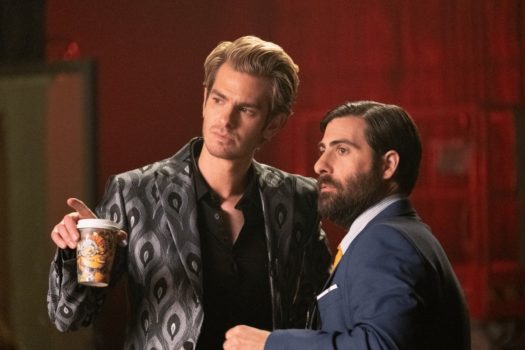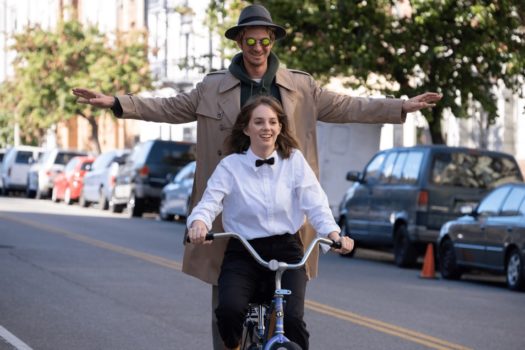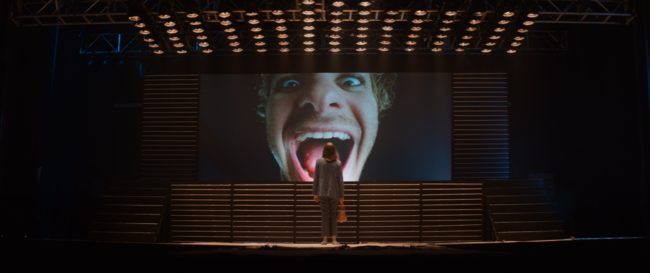
Andrew Garfield in “Mainstream”
Social media satire “Mainstream” by Gia Coppola (Palo Alto) starring Andrew Garfield (The Amazing Spider-Man) and Maya Hawke (Stranger Things) was released at the Venice International Film Festival in September 5 2020 and on VOD on May 7 2021.
“Mainstream” tells the story of Frankie (Hawke), a young woman who is bored with her bar-tending job. By chance she befriends a mysterious man named Link (Garfield) who scoffs at the mainstream and even refuses to own a phone. She finds Link charismatic and decides to make an online celebrity out of him. Frankie starts posting videos of Link’s anti-establishment critiques which rapidly gain popularity on YouTube. Link develops an online persona of “No One Special” and gains viral fame. Quite soon they both start achieving their goals. Later they become romantically entwined, but Frankie does not know Link’s full life story, and his past threatens to catch up with him. Additionally internet stardom comes with its dark side.
“Mainstream” had a moderate audience success, but has also received many negative critical reviews. Nevertheless, the film is definitely underestimated. In reviews critics claimed it to be full of cliches and Garfield’s character Link to be unlikable and having no redeeming qualities. This is true, but there are valid reasons behind these creative decisions. Our life is full of cliches and “Mainstream” reflects this, also Link is supposed to be off-putting. Brilliant acting by Garfield makes this film a real masterpiece and is destined to become a cult classic. Link is an outrageous and eccentric character and Garfield’s frenetic energy is just right for the role. Newcomer Maya Hawke also gives an adequate performance. “Mainstream” has impressive and atmospheric cinematography by Autumn Durald, the story is both gripping and realistic. In our social media obsessed times ordinary people can become famous influencers for no reason via meaningless vlogs, yet can also lose everything due to cyber-bullying, which can drive people to depression and suicide. The film reflects this, so calling “Mainstream” superficial is missing the point, because it is intended to show the superficiality of our lives.
Coppola has said that her film was inspired by Elia Kazan’s “A Face in the Crowd” which starred Andy Griffith and Patricia Neal. Griffith’s character is a drifter who first experiences success on the radio and later becomes a television host who ends up using his show as a gateway to political power. But despite being openly influenced by “A Face in the Crowd”, Coppola has created “Mainstream” as a distinct and separate work using her own unique vision. Gia Coppola proves yet again to be a filmmaker to watch out for, and to be a worthy successor of the Coppola film-making legacy.

Garfield and Hawke in “Mainstream”
Interview with director Gia Coppola
Tell us about the story behind Mainstream. How did the idea come to you?
After I had made my first film, Palo Alto, I was thinking about what inspired me and if I were to make another film, what would it be? I was watching Turner Classic Movies and I wasn’t fully paying attention, but I caught the end of the Elia Kazan’s A Face in the Crowd. The ending was so haunting, with Andy Griffith maniacal laugh and the last shot of a glittering Coca–Cola billboard that fades to black. I immediately searched for the film so I could watch it from the beginning. Even though the film was made in the 1950’s, it felt dangerously relevant to me. It’s essentially a satire about the transition from radio to television, the power of entertainment, but at the core it is a heartbreaking love story with a sort of Frankenstein undertone; a young woman (Patricia O’Neil) who creates a monster (Andy Griffith).
My friend was working at Maker Studios at the time representing YouTubers. I didn’t understand what she did for a living; Millions of people all around the world tune in to watch people play video games, unbox toys etc. My friend said: “They’re so
mainstream, mainstream doesn’t even know it yet” I was baffled that people found this engaging, there was no story, just charisma.
I craved to figure out a way to combine these two worlds: A Face in The Crowd and the fast–approaching internet stardom. I also, wanted to express and understand personal avenues and what I was feeling when I went on social media; what constitutes popularity, the struggles of trying to be creative in a modern age of “cool” and growing from a teenager into a woman.
With Mainstream being your second feature, can you talk about the development and production process, and any significant departures from your debut?
I think the typical “Hollywood” route is you make an indie film, then you get hired to retell the same story again but with more money and more producers. I wanted to get the story of Mainstream out of my system and challenge myself. It’s a weird movie, so it took a long time to find the right people to partner up with that believed in it. I was grateful to team up with the producer Fred Berger. I then pitched the concept to
Andrew Garfield, who eventually came on board, and introduced me to Tom Stuart, who I collaborated with to finish the script.

Garfield in “Mainstream”
Were there any major challenges?
Shooting for only 19 days was way harder than I anticipated.
Can you tell us about the casting process and working with Maya Hawke and Andrew Garfield? And Nat Wolff, who was also in Palo Alto?
I always knew Nat Wolff was going to be in it: I wrote the character for him. On Palo Alto he was such troubled character, but in real life he’s a really sweet kid. One night while we were hanging out, he was idly playing a song he wrote called “Winter Baby” I thought was so moving, it became the basis for his character Jake, and is also in the movie.
I am a huge fan of Andrew Garfield, he’s one of the greatest actors of our time. I met Andrew a while back because we work with the same acting coach, Greta Seacat. Before the script even existed, I was loosely talking about how I was feeling towards pop–culture and my love for Face in the Crowd. He was passionate about the same things I was looking to express. He’s extremely intelligent but also has a sense of humor and can dance. I felt he could help and teach me, but he also has a sweetness that could play against the character.
Andrew, Tom and I were working on the script. I still hadn’t found the right actress to play Frankie. I had just photographed Maya for Zac Posen look book and we really hit it off. Even when photographing her, Maya always seemed to be able to read my mind and know exactly what I was looking for. I had her fly down to do a reading with Andrew and she won everyone over, it was without a doubt we had found our Frankie.
Talk about working with cinematographer Autumn Durald, who also worked on Palo Alto.
Autumn is one of my best friends. It’s effortless between the two of us. I trust her whole–heartedly.
What is your favorite memory from production?
I don’t want to give it away, but there’s a scene where Andrew does something very radical down Hollywood Blvd.
Mainstream approaches very timely, complex, and also sensitive topics. What do you hope audiences take away from the film?
I feel it’s a kind of cautionary fairytale about what our culture values and the psychological dangers that can come with it, but also tells a story about storytelling. I hope the film inspires or helps people to find self–acceptance within themselves, and that each journey is unique to oneself.
Do you have any favorite films or filmmakers that influence your work?
I’m influenced by so many different things but the movies I watched over and over again for Mainstream were: Broadcast News, Network and Face in the Crowd.
